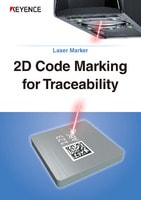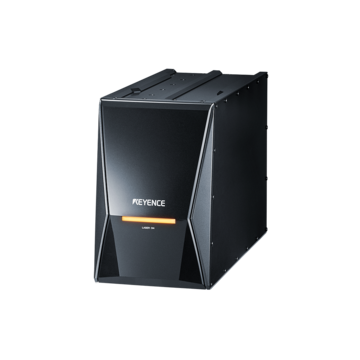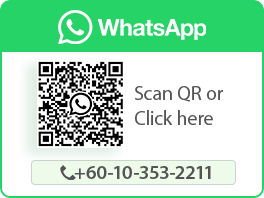Laser Marking Systems / Laser Markers
Laser Etching: A Complete Guide
-
Tags:
- Laser Etching , Glass , Metal
Have you ever noticed textured marks that spell out a company logo or serial number?
Did you know that those marks are typically made through a laser etching process?
Laser etching is part of the 3.2 billion dollar laser marking machine industry that’s dominating the manufacturing world. It is a marking method that uses a laser to manipulate the surface into a mark that is raised or has shallow depth. Although there are plenty of marking methods out there besides laser etching, such as chemicals, printing, and stamping, laser etching has efficiency, permanency, and environmental compatibility that these other processes don’t have.
With laser etching taking only seconds to add a permanent and high contrast mark on wood, glass, and metal, every industry is joining in on its use. Laser etching makes designs, logos, 2D codes, and identification marks for a diverse set of products, from car doors to pills.
Although the surface-level capabilities are easily some of the biggest highlights of the technology, it should not be the only focal point. Several other key areas help the technology stand out. Some of these include its versatility in different manufacturing processes, operational efficacy, environmental benefit, and overall superiority to many alternative etching laser methods.
So, how does the laser etching process work, and how is it used? In the following guide, we’ll take a look at the ins and outs of this ubiquitous process.
What is Laser Etching?
Laser etching is a no-contact marking method that creates raised or engraved marks (as deeply or shallowly as desired) on a target. These marks are used for traceability, aesthetics, logos, designs, or adhesion. Laser etching uses a laser beam that is generated inside of a laser marking machine.
To laser etch, first you need to upload or design the mark that you want etched and then set the parameters for the given material you are etching. The laser marking machine analyses this information and completes the etching process.
The marking parameters you input determine whether the mark will be black, grey, or white. Anything ranging from slightly raised marks to contrasting marks with no surface finish change to deeply engraved marks can all be achieved with a single laser etching machine.
Laser etching technology has made strides in recent years but isn’t new to the manufacturing industry. The associated technology has been evolving and improving for decades, eventually reaching a point where it nearly trumps traditional production methods in every way.
It is important to point out that laser etching vs engraving are not the same thing, but both practices have made substantial improvements with the help of the technology. So, what is laser etching in today’s world? Well, it includes opening a can of new concepts and ideas that are guaranteed to help lead the manufacturing industry into the future.
We’re here to provide you with more details.
Reach out today!

How Does Laser Etching Work?
This question can be answered from several specific angles, but the whole of laser etching technology can be explained with a bird's eye view. With the help of a pulsed laser beam, materials absorb part of this energy to create localised heat. These temperatures are so high that they inevitably melt and shape a very specific area on the part in question.
It may not sound very accurate, but you'd be surprised by the results. From finite text to much larger logos and decals, laser marking systems can deliver outstanding, consistent results. This approach is much more efficient, effective, and consistent than the likes of chemical etching, for example. As one might expect, these capabilities lead to use in many different applications and benefits.
Curious about our pricing?
Click here to find out more.

Applications of Laser Etching
Manufacturers have been applying the technology's capabilities to many different types of products and unique industries. The list of applications continues to grow with each passing year, spanning from fabric laser etching to car parts, many aspects of aerospace designs, and more.
More specific examples include:
- Universal traceability
- Reliable marking for medical devices
- Unbounded personalisation
- Quality branding that stands the test of time
These various applications shouldn't be confused with the numerous benefits that stem from the technology's output. It is much more than just efficiency and a few bells and whistles.
We’re here to provide you with more details.
Reach out today!

Benefits of Using Laser Etching
What is laser etching used for, and why is it so common? Diving into the process reveals the many long-term benefits for manufacturers, their employees, and consumers. Aside from being a much more eco-conscious approach, its consistent precision, high permanency, and modern customisations benefit everyone.
Consumers are happier with higher quality products, manufacturers improve efficiency and lower costs, and employees deal with less physical labour and frustrating downtime. Although this technology has been evolving for quite some time, it isn't far off from becoming the new norm.
Discover more about this product.
Click here to book your demo.

Is Laser Etching Permanent?
Yes, laser etching is permanent.
Etched marks are resistant to friction, wear and tear, and contaminants like liquids. The strength against outside forces is why etched marks are frequently used for traceability and identification marks, especially in industries like aerospace, automotive, and medical
devices.
We’re here to provide you with more details.
Reach out today!

What Materials Can Be Laser Etched?
This process is common across industries as many materials can be used. Here are some of the most common:
Laser Etching Metal
To laser etch metal, the best laser to use is a fibre laser. Using a fibre laser is essential for metal for the most visible etched marks. Metal absorbs fibre beams the easiest and the fastest.
Fibre lasers use a wavelength of 1090 nm to etch metals like stainless steel, aluminium, and iron. Almost every industry—automotive, aerospace, medical device, EV, battery, semiconductor, food/pharmaceutical—benefits from laser etching metal. Look at any product you have from these industries, such as car doors, phone batteries, and packaging, and you will find an etched mark.
Traceability and identification are a necessity for etching as regulatory bodies require marks to be high contrast and permanent. Although there are other options for adding these marks that fit these requirements, the efficiency and environmental impact make etching a more desirable choice. Laser etching metal is exponentially faster than options like chemical etching, and it does not use consumables, either.
In addition to traceability and identification, laser etching metal is also proven to be effective for adhesion preparation. A study by NASA found that laser etching is as effective as Pasa-Jell pre-treatment without having a chemical reaction.
Laser Glass Etching
Since glass has a different material structure and absorption levels, it differs from metal etching. Instead of using a fibre laser for glass, the best glass etching machine is a CO2 laser. CO2 lasers have a 10600 nm wavelength and are better absorbed and reflected by glass. Microcracking the surface of glass creates etched marks, and fine-tuning this process can ensure an aesthetic-looking mark without degrading the properties of the glass.
Laser glass etching is common in the food & pharmaceutical industry for beverage bottles. The etched glass is eye-catching as a design or lot/date code. It is also common for windows in the automotive or aerospace industry to have traceability marks.
Plastic/Resin Laser Etching
Plastic and resin materials are commonly laser etched because it’s a precise and versatile method to do so. Since UV lasers operate under a shorter wavelength, they are preferred for their effectiveness on intricate and fine-detailed plastics. As some plastics are sensitive to heat, UV lasers do not stress the material during the engraving process. They also provide a high level of control, which allows for sharp and clear markings.
Curious about our pricing?
Click here to find out more.

How Fast is Laser Etching?
Laser etching is an extremely fast and efficient process, often completed in just seconds.
For comparison, chemical etching, laser etching’s direct competitor, requires nine steps and takes days to complete.
How to Implement Laser Etching in Manufacturing
Asking the question, “How is laser etching done,” might make you think it only applies to a handful of subsectors in manufacturing. This isn’t true by any means, as adaptable laser technology has made it applicable to nearly every angle of manufacturing in today’s world.
Products and parts come in all shapes, sizes, and materials, making laser marking and etching technology a must-have. Laser etching tech can be easily integrated with existing processes, even alongside traditional machinery.
You won’t be required to completely overhaul your current process, and the technology is the perfect option for those who prefer a slow transition. One machine won’t have any trouble proving itself, streamlining production, improving quality control, and aiding business growth.
We’re here to provide you with more details.
Reach out today!

KEYENCE’s Laser Etching Machines
If you need to laser-etch glass, wood, or metal, KEYENCE offers machines that can do just that. We offer a 3-Axis CO2 Laser Marker ML-Z Series laser marking machine, among other hybrid, fibre, green, and ultra-violet systems. All of these laser marking machines are ideal for etching and other laser processing like engraving and cutting.
All KEYENCE laser etching machines work for your versatile shapes, sizes, and focal points. The laser etching machines feature 3-axis control and autofocus, meaning that they are able to mark with extreme precision over wide fields and varying focal depths. This control differs from most laser etching machines, which require the technician to move the target for the correct positioning. Because of the variable lens cluster built within the laser head, these machines etch cylinders, slopes, stepped shapes, and other non-geometric shapes without distortion or manual movement.
Curious about our pricing?
Click here to find out more.

Explore the Future of Precision with Laser Etching
Laser etching is a marking process used on wood, metal, and glass for traceability marks, logos, and designs. Using a laser etching machine instead of other marking methods will speed up your marking process and improve your design precision.
If you need assistance choosing a laser etching machine or need more information, KEYENCE can help you. Our team is ready to answer your questions. We offer demos, specialists, and trials for you to get your most suitable etching machine. Contact us today to learn about your future with laser etching.
We’re here to provide you with more details.
Reach out today!

Related Downloads
![LASER TECH BRIEFS [Marking Fundamentals]](/img/asset/AS_47523_L.jpg)
Understand the Technology Behind KEYENCE Laser Markers.


![TIPS for MARKING IMPROVEMENT [Product Labeling]](/img/asset/AS_46976_L.jpg)



